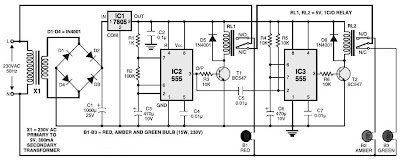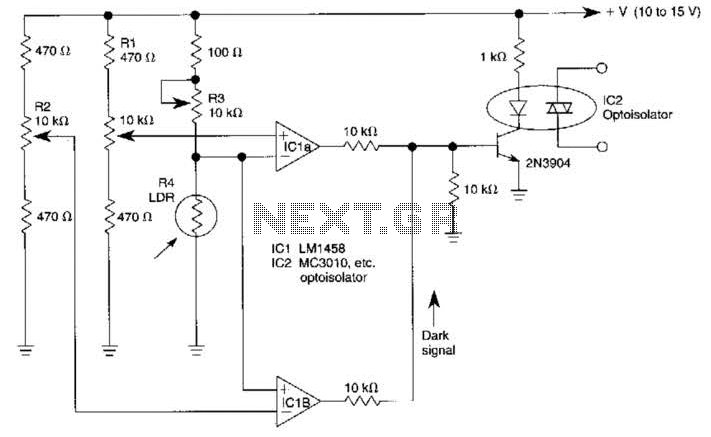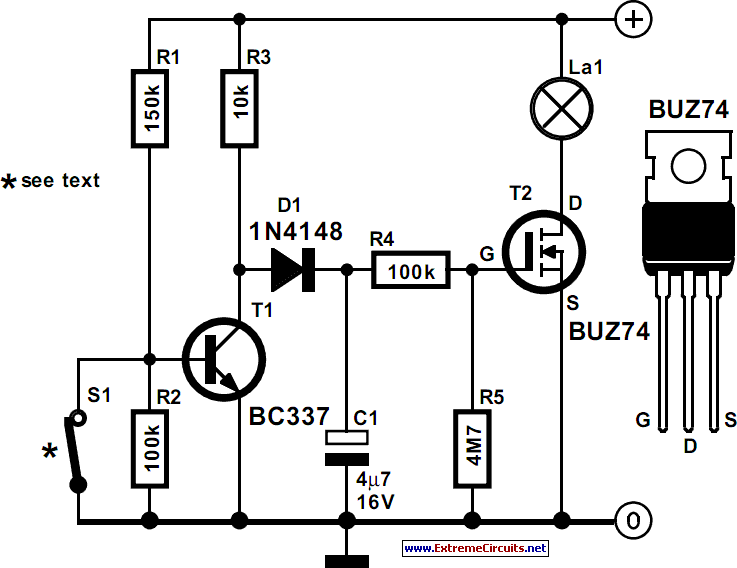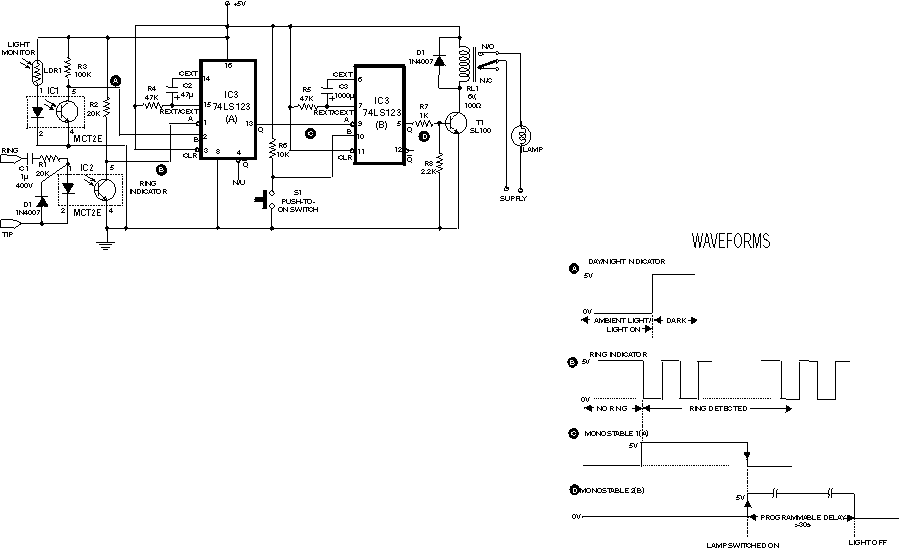
Courtesy light extender
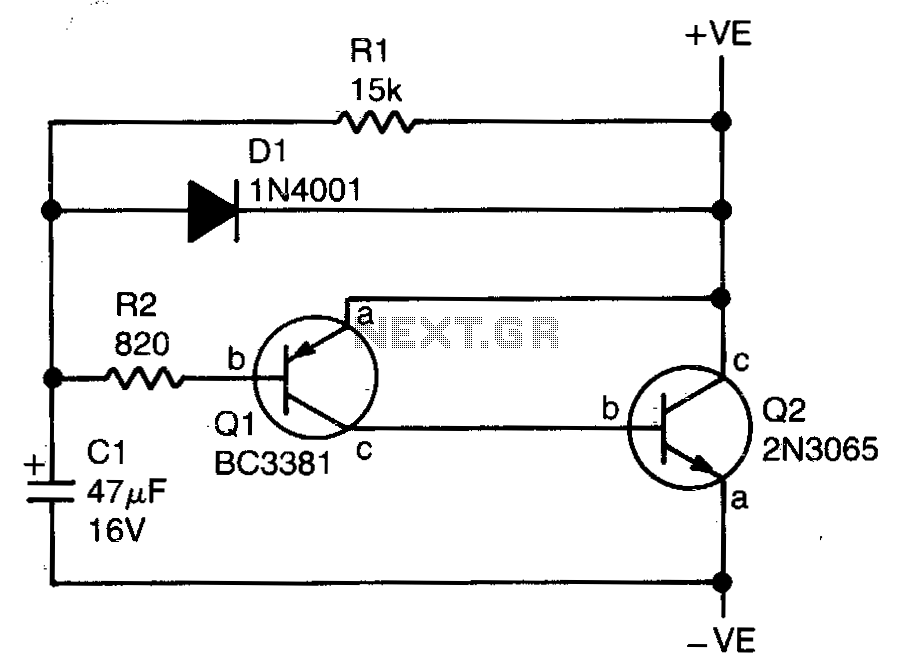
Most car door switches are single-pole switches, with one side grounded. When the door is opened, the switch grounds the other line, completing the light circuit. In vehicles where the negative terminal of the battery is connected to the chassis, the negative wire of the unit (emitter of Q2) is connected to the chassis, while the positive wire (case of 2N3055) is connected to the wire leading to the switch. In vehicles with a positive ground system, this connection sequence is reversed. When the switch closes (door open), C1 is discharged via D1 to zero volts, and when the switch opens, C1 charges through R1 and R2. Transistors Q1 and Q2 are configured as an emitter follower (Q2 buffers Q1), causing the voltage across Q2 to increase slowly as C1 charges. Consequently, Q2 functions as a low-resistance path in parallel with the switch, keeping the lights on. The value of C1 is selected to achieve a useful light level for approximately four seconds; thus, the light intensity diminishes until it is completely off in about ten seconds. Variations in transistor gains and current drain due to different car types may affect timing but can be easily adjusted by selecting a different C1.
The circuit operates by utilizing a simple yet effective design to control the interior light of a vehicle through the door switch mechanism. The single-pole switch is strategically grounded, allowing for a straightforward completion of the circuit when the door is opened. This design is versatile, accommodating both negative and positive ground systems in vehicles by adjusting the connections accordingly.
When the door is opened, the switch closes, leading to the discharge of capacitor C1 through diode D1. This rapid discharge brings the voltage across C1 to zero, initiating the charging process once the switch is opened. Resistors R1 and R2 play a critical role in controlling the charging rate of C1, allowing for a gradual increase in voltage across transistor Q2. The emitter follower configuration of Q1 and Q2 ensures that Q2 can effectively buffer the output, maintaining a stable voltage level that keeps the lights illuminated.
The timing of the light activation is determined by the capacitance of C1. By selecting an appropriate value for C1, the circuit can be fine-tuned to provide a desired light duration. The design allows for a light level that is perceptible for about four seconds before gradually dimming over the next six seconds until the lights are completely off. This gradual reduction in light intensity enhances the user experience by preventing abrupt changes in lighting, which can be jarring in a vehicle environment.
In summary, this car door switch circuit exemplifies a practical application of basic electronic components to achieve a functional and user-friendly lighting system in vehicles. The ability to adjust C1 to accommodate different vehicle types and configurations adds to the circuit's versatility and effectiveness.Most car door switches are simply single-pole switches, with one side grounded. When the door is opened the switch grounds the other line thus completing the light circuit. In a car where the negative terminal of the battery is connected to the chassis, the negative wire of the unit (emitter of Q2) is connected to chassis the positive wire (case of 2N3055) is connected to the wire going to the switch. In a car having a positive ground system this connection sequence is reversed. When the switch closes (door open), CI is discharged via D1 to zero volts, and when the switch opens, Cl charges up via R1 and R2.
Transistors Ql and Q2 are connected as an emitter follower (Q2 just buffers Ql) therefore the voltage across Q2 increases slowly as Cl charges Hence Q2 acts like a low resistance in parallel with the switch and keeps the lights on. The value of Cl is chosen such that a useful light level is obtained for about four seconds; therefore the light decreases until in about 10 seconds it is out completely. With different transistor gains and with variation in current drain due to a particular type of car, the timing may vary hut may be simply adjusted by selecting Cl.
The circuit operates by utilizing a simple yet effective design to control the interior light of a vehicle through the door switch mechanism. The single-pole switch is strategically grounded, allowing for a straightforward completion of the circuit when the door is opened. This design is versatile, accommodating both negative and positive ground systems in vehicles by adjusting the connections accordingly.
When the door is opened, the switch closes, leading to the discharge of capacitor C1 through diode D1. This rapid discharge brings the voltage across C1 to zero, initiating the charging process once the switch is opened. Resistors R1 and R2 play a critical role in controlling the charging rate of C1, allowing for a gradual increase in voltage across transistor Q2. The emitter follower configuration of Q1 and Q2 ensures that Q2 can effectively buffer the output, maintaining a stable voltage level that keeps the lights illuminated.
The timing of the light activation is determined by the capacitance of C1. By selecting an appropriate value for C1, the circuit can be fine-tuned to provide a desired light duration. The design allows for a light level that is perceptible for about four seconds before gradually dimming over the next six seconds until the lights are completely off. This gradual reduction in light intensity enhances the user experience by preventing abrupt changes in lighting, which can be jarring in a vehicle environment.
In summary, this car door switch circuit exemplifies a practical application of basic electronic components to achieve a functional and user-friendly lighting system in vehicles. The ability to adjust C1 to accommodate different vehicle types and configurations adds to the circuit's versatility and effectiveness.Most car door switches are simply single-pole switches, with one side grounded. When the door is opened the switch grounds the other line thus completing the light circuit. In a car where the negative terminal of the battery is connected to the chassis, the negative wire of the unit (emitter of Q2) is connected to chassis the positive wire (case of 2N3055) is connected to the wire going to the switch. In a car having a positive ground system this connection sequence is reversed. When the switch closes (door open), CI is discharged via D1 to zero volts, and when the switch opens, Cl charges up via R1 and R2.
Transistors Ql and Q2 are connected as an emitter follower (Q2 just buffers Ql) therefore the voltage across Q2 increases slowly as Cl charges Hence Q2 acts like a low resistance in parallel with the switch and keeps the lights on. The value of Cl is chosen such that a useful light level is obtained for about four seconds; therefore the light decreases until in about 10 seconds it is out completely. With different transistor gains and with variation in current drain due to a particular type of car, the timing may vary hut may be simply adjusted by selecting Cl.
